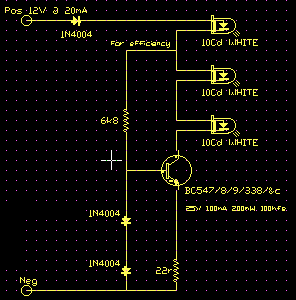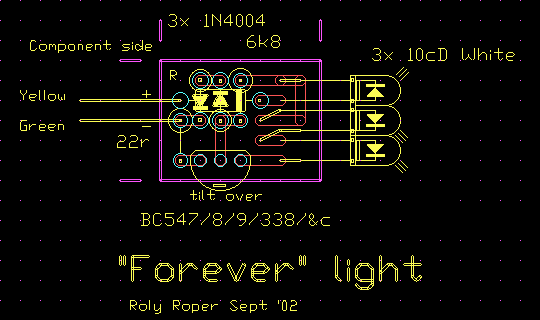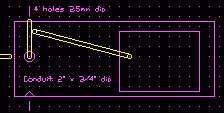The arrival of affordable white LED's with a high light output has turned attention back to the use of LED's for lighting rather than just indicators.
Light output is still low but it is now high enough to be useful in many situations around the car, boat, and home.
12 volt situations aren't limited to vehicles and boats. There are a growing number of people living on 12 volt systems.
The typical lights used in this domestic service are 20 watt Quartz Iodine - QI (also called halogen and dichroic) although 10 watt and even 5 watt are sometimes used.
Even at much lower light levels LED's have several attractions.
- very low power consumption - can be left on for stairs, nightlights, etc.
- tiny - mounting in previously impossible places
- cool - a QI has to run very hot to work
- safe - wired-in they are safer in hazardous areas such as around batteries, gas and fuel stores.
There are a couple of potential problems in designing a LED light for 12 volt operation:
- Normal system voltage is quite variable (11 to 15V)
- Abnormal solar system voltages can be as high as 25V
The normal resistor method would work in the normal case although the brightness would vary with battery voltage, but under fault conditions the light would be damaged.
My answer is to use a simple constant current source (or sink in this case) to solve these problems.
Caution: At even 5Cd one of these LED's is a sock in the eye if you look directly into it. All the more so at 10 or 20Cd. Your eye is telling you "don't".
Circuit

The diode in the supply provides protection against accidental reversal. Its voltage drop isn't a problem as explained below.
If you want to fit internal protection a 22 ohm 1/8W resistor in series with the supply makes a more reliable fuse than fusewire at these low currents.
Operation
The transistor and surrounding components make a constant current sink, or current regulator.
The transistor draws the set current into its collector, changing the collector voltage to maintain the current constant.
First we note that the voltage drop across the load, the LED's, is pretty well constant because they are diodes with a particular forward conduction threshold or Vgamma.
The quoted voltage for one LED is 3.6 volts, so the total for three in series is 10.8 volts.
The two foward biased diodes provide a voltage reference to the base of the transistor. Since the base-emitter drop roughly equals one diodes worth, the voltage drop across the resistor will equal the voltage of the remaining diode.
If the voltage across the emitter resistor is low the transistor is biassed on to pass more collector current and bring the emitter voltage up. If it is too high the collector current reduces.
The constant current is therefore set by Ohms Law:
How constant it really is depends mainly on temperature shift, and transistor gain if its low.
Since real diodes and transistors don't neatly match up in voltage drop some tweeking of the emitter resistor may be required depending on the particular diodes and transistors used.
The forward bias current for the diode pair is quite small and would normally be taken directly from the supply, and in some physical situations you may find it easier to do so.
In this case I decided to take it from the join of the top two LED's to screw the last drop of efficiency out of the circuit. So this current flows through the upper LED and adds its tiny bit to the light output.
The circuit is very tolerant of transistor parameters as long as they meet or exceed:
- Collector voltage - 25V
- Collector current - 100mA
- Power dissipation - 200mW
- Current gain (hfe)- 100
Layout

The layout is uncritical and there is considerable scope for variation and creativity.
The most important aspect on battery power is to avoid any possibility of a short circuit on the supply.
Construction
A number of these boards have been constructed using dab board.
Testing
It actually is important to at least check that all the LED's are connected the right way around. They may be diodes at heart, but they have a very low reverse voltage withstand.
Packaging
A very simple case can be mode from 2 inches/50mm of 3/4 inch/20mm plastic electrical conduit.

Four holes are drilled in the top to allow the power wires to be tied off, and hang shining down.
The lack of heat and the small size should let your imagination and creativity run riot.